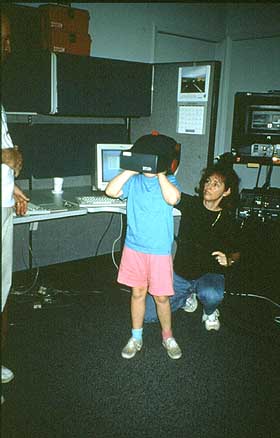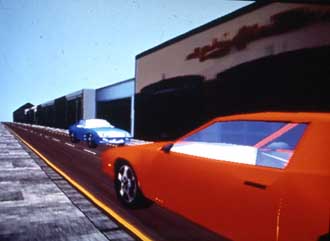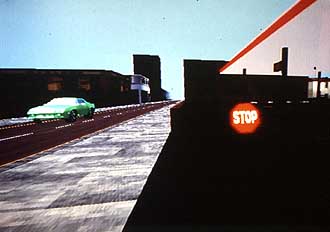VR OFFERS BIG STEP FORWARD FOR CHILDREN WITH AUTISM

Shannon in headmount display assisted by Dr. Dorothy Strickland
Suppose you could not cross a street, or talk, or recognize and use a forků
Seven-year-old Shannon takes two steps forward, sees the stop sign at the curb, and stops to let a blue car pass slowly down the flat, gray street in front of her. These may be small steps for a typical seven-year-old, but for Shannon, they are groundbreaking.
Shannon is "classically autistic": isolated, disconnected from her surroundings, virtually unable to speak, easily upset by change, and overwhelmed by the complexities of the real world. Like almost all children and many adults with autism, she has never crossed a real street by herself. She has taken these giant steps in a safe, controllable, computer-generated virtual world constructed by North Carolina State computer scientist and electrical engineer Dorothy C. Strickland, PhD.
In 1994, Dr. Strickland was searching for a patient population that could take advantage of the relatively simple, often cartoony graphics generated by early VR systems. Children with autism were a perfect fit for the technology.
Explains Dr. Strickland: "With children with autism, the problem is often that the world is too complex. Virtual reality did exactly what had been prescribed that one should do with these children: simplify the world and make it safe, basic, repeatable and familiar to them."
Working with a team of volunteers from TEACCH (Treatment and Education of Autistic and Related Communications Handicapped Children) at the UNC Medical School and members of NC State's Computer Science Department, Strickland devised an experiment to test whether severely learning-challenged children with autism like Shannon could learn a basic, real-world skill like street-crossing by practicing it first in the virtual world.
Strickland designed a purposely simple virtual environment: a flat, gray street with no-frills buildings and sidewalk, one slowly moving car (in either red or blue, the only two colors Shannon recognizes), and a single stop sign, easily repositioned by the computer. In a series of five-minute sessions spaced over a few weeks, Shannon donned a computer-linked VR helmet which shut out her view of the real world and replaced it with Strickland's three-dimensional street scene. The helmet also tracked Shannon's head movements in the real world, and changed the virtual world in response: as she walked forward, the street appeared to get closer.

Strickland had worried that Shannon might have difficulty accepting the helmet and its generated world. But by the end of the first day's sessions, a completely entranced Shannon had tracked the movement of the virtual car, identified it by saying "ca" (her word for "car"), and correctly recognized its color as "bu." By her last session, Shannon had walked down the sidewalk, turned around, found the stop sign in its new position, walked up to it, and stopped to let the "bu ca" pass.

"It was very gratifying to see that VR has the potential for aiding in this serious disorder," says Strickland. "There are so few techniques that effectively address the problems. Parents of children with autism are desperate." Shannon still doesn't cross real streets by herself. However, says her father proudly, two years after those first sessions, she is still stopping at the curb, watching for cars, and looking both ways -- a big step with no small consequences for healing.
In a follow-up study, Strickland trained Shannon and several other children with autism to recognize and use everyday objects in a virtual kitchen: a spatula, a cup, a fork. After their training, the children were able to use the same objects in the real world, often for the first time.
Strickland has now conceived of, created and launched a NIH-funded website to provide free online information and learning tools for those with special learning needs: dotolearn.com. The website aims to deliver solutions to parents, teachers and health professionals, and learning opportunities to special needs adults and children, including those with autism.
The website includes free, printable make-and-take tools such as picture cards and schedule cards (available for sale commercially, but expensive and hard to find). It also features information on a range of learning disorders, including definitions, strategies for treatment, and useful links and chat rooms. Strickland's site also includes what she calls "fun stuff," such as a kids' magazine and do-it-yourself art projects.
And under development and coming soon, the site will feature virtual reality safety and learning games - the first VR child safety and learning games every delivered via the web. These include a social skills game for kids eight through eleven years old, in which the children must make the right social decisions to move along a game board, as well as street-crossing and fire-safety games for younger children.
The fire safety game is Strickland's response to a FIMA directive which advises parents that children should be given a safe "meeting place" to go to in case of fire where they can safely wait for their parents. In Strickland's game, the children use a mouse to move through a virtual house. Once acclimated, they meet Flash, an animated dog who shows them how to move through the house and out the back door to a safe meeting place - a tree in the outside yard.
Then the house begins to catch (virtual) fire. Flash directs the children to follow him to their meeting place. As they follow, they pass spots which trigger Flash to turn around and offer encouragement. If they do not follow Flash, he returns and attempts to persuade them to follow him. If they move toward the flame (they are blocked from actually entering the flame), an alarm sounds and grows louder and louder.
Stickland has recently tested the game on several children with varying disorders including autism. In each case, after several test sessions, the children came home and asked their parents to select a meeting place they could go to in case of fire. Of course, says Strickland, in a real fire, the children may default to typical "hiding behavior." Or, if they've practiced sufficiently in VR, they may indeed go to their safe meeting place in the real world. In any case, notes Strickland, the game raises the level of discussion in the home in accordance with FIMA prescriptions.
Says Strickland: "When I first starting using VR to treat children with autism, I thought I was helping them understand and adjust to our world. But if I in any way taught them how to move in this reality, they taught me much more about what reality is - a healing for me as well." She dedicates dotolearn.com "particularly to those individuals who may simply see the world in ways we do not yet understand."
See dotolearn.com for more information.